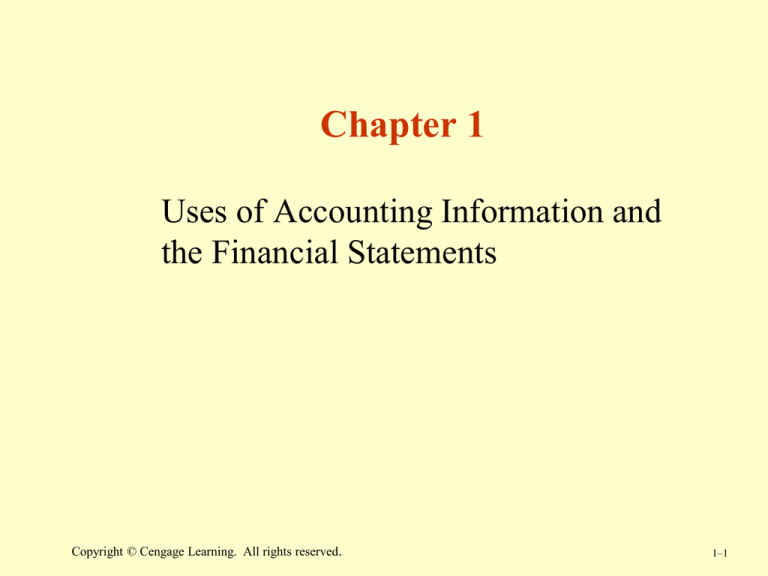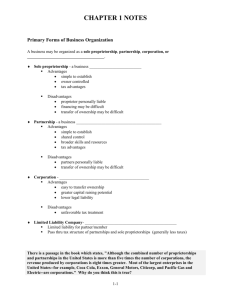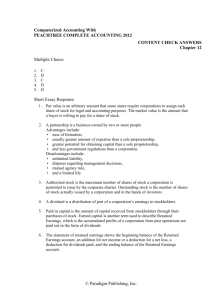
Chapter 1
Uses of Accounting Information and
the Financial Statements
Copyright © Cengage Learning. All rights reserved.
1–1
Financial and Management
Accounting
• Accounting’s role is divided into two categories:
– Management accounting
– Financial accounting
• The functions of both categories overlap.
• The primary difference between the two is the
principal users of the information.
Copyright © Cengage Learning. All rights reserved.
1–2
Management Accounting
• Provides internal decision makers who are charged
with achieving the goals of profitability and
liquidity with information about financing,
investing, and operating activities.
• Used to report past performance and expected future
performance.
Copyright © Cengage Learning. All rights reserved.
1–3
Financial Accounting
• Generates reports and communicates them to
external decision makers so they can evaluate how
well the business has achieved its goals.
• Financial information of company is reported in the
financial statements.
• Used to report directly on goals of profitability and
liquidity.
Copyright © Cengage Learning. All rights reserved.
1–4
Accounting Measurement
• Objective 3
– Explain the importance of business transactions,
money measure, and separate entity.
Copyright © Cengage Learning. All rights reserved.
1–5
Accounting Measurement
To make an accounting measurement, the accountant
must answer four basic questions:
– What is measured?
– When should the measurement be made?
– What value should be placed on what is
measured?
– How should what is measured be classified?
Copyright © Cengage Learning. All rights reserved.
1–6
Business Transactions
• Economic events that affect the financial position of a
business
– An exchange of value
• Purchase
• Sale
• Payment
• Collection
• Loan
– Events that have the same effect as an exchange of value
(nonexchange transactions)
• Loss from fire, flood, theft
• Physical wear and tear on equipment
• Accumulation of interest
Copyright © Cengage Learning. All rights reserved.
1–7
Money Measure
• Recording of all business transactions in terms of
money.
• Money is only factor common to all business
transactions.
• Basic unit of money determined by country in
which business resides.
• Exchange rates used to translate transactions from
one currency to the other.
Copyright © Cengage Learning. All rights reserved.
1–8
Separate Entity
• A business is considered distinct from its
– Owner(s)
– Creditors
– Customers
• Its financial records and reports should refer only to
its own financial affairs.
Copyright © Cengage Learning. All rights reserved.
1–9
Financial Position and the
Accounting Equation
• Objective 5
– Define financial position, and state the
accounting equation.
Copyright © Cengage Learning. All rights reserved.
1–10
Accounting Equation
• Assets = Liabilities + Stockholders’ Equity
• The two sides of the equation must always stay in balance.
• Assets
– Economic resources owned by a company that are
expected to benefit future operations
• Liabilities
– Present obligations of a business to pay cash, transfer
assets, or provide services to other entities in the future
– Represent claims of creditors to the assets of the business
• Stockholder’s Equity
– Represents the claims of the owners of a corporation to
the assets of the business
Copyright © Cengage Learning. All rights reserved.
1–11
Stockholders’ Equity
Stockholders’ Equity = Contributed Capital + Retained Earnings
Contributed capital
Amount invested in the business by the stockholders
Retained earnings
Stockholders’ equity that has been generated by operations
and kept for use in the business
Copyright © Cengage Learning. All rights reserved.
1–12
Financial Statements
• Objective 6
– Identify the four basic financial statements.
Copyright © Cengage Learning. All rights reserved.
1–13
Four Major Financial Statements
•
•
•
•
Income Statement
Statement of Retained Earnings
Balance Sheet
Statement of Cash Flows
Copyright © Cengage Learning. All rights reserved.
1–14
Income Statement
• Summarizes revenues earned and expenses incurred
over an accounting period.
• Dated “For the Month Ended …” or “For the Year
Ended …”
• Shows whether a company achieved its profitability
goal.
Copyright © Cengage Learning. All rights reserved.
1–15
Income Statement
Date reflects revenues
and expenses incurred
over a period of time
Weiss Consultancy, Inc.
Income Statement
For the Month Ended December 31, 2010
Revenues
Commissions earned
Expenses
Equipment rental expense
Wages expense
Utilities expense
Total expenses
Income before income taxes
Income taxes expense
Net income
$14,000
$2,800
1,600
1,200
5,600
$8,400
1,200
$7,200
Net income figure used to prepare
statement of retained earnings
Copyright © Cengage Learning. All rights reserved.
1–16
Statement of Retained Earnings
• Shows changes in retained earnings over an
accounting period
• Dated “For the Month Ended …” or “For the Year
Ended…”
• Uses net income figure from income statement
• Retained Earnings end of period balance used to
prepare balance sheet
Copyright © Houghton
Cengage Learning.
Mifflin Company.
All rights All
reserved
rights. reserved.
1–17
Statement of Retained Earnings
Weiss Consultancy, Inc.
Statement of Retained Earnings
For the Month Ended December 31, 2010
Retained earnings, December 1, 2010
Net income for the month
Subtotal
Less dividends
Retained earnings, December 31, 2010
Ending balance of retained
earnings used to prepare the
balance sheet
Copyright © Cengage Learning. All rights reserved.
$
0
7,200
$7,200
2,400
$4,800
Net income figure comes
from income statement
1–18
Balance Sheet
• Shows the financial position of a business on a
certain date.
• Often called the statement of financial position.
• Presents view of business as holder of assets that are
equal to the claims against those assets.
• Claims consist of the company’s liabilities and the
stockholders’ equity.
Copyright © Cengage Learning. All rights reserved.
1–19
Balance Sheet
Date reflects account
balances as of a
certain date
Weiss Consultancy, Inc.
Balance Sheet
December 31, 2010
Assets
Cash
Accounts receivable
Supplies
Land
Building
Liabilities
$61,200
4,000
2,000
40,000
100,000
Accounts payable
$ 2,400
Stockholders’ Equity
Common stock
Retained earnings
$200,000
4,800
Total stockholders’ equity
Total assets
$207,200
Total liabilities and
stockholders’ equity
204,800
$ 207,200
Ending balance of Retained Earnings comes
from statement of retained earnings
Copyright © Cengage Learning. All rights reserved.
1–20
Statement of Cash Flows
• Shows cash flows into and out of a business during
an accounting period.
• Shows important investing and financing
transactions of the period.
• Focuses on liquidity.
• Explains how the cash account changed during the
period.
Copyright © Cengage Learning. All rights reserved.
1–21
Statement of Cash Flows
Weiss Consultancy, Inc.
Statement of Cash Flows
For the Month Ended December 31, 2010
Cash flows from operating activities
Net income
Adjustments to reconcile net income to net cash
flows from operating activities
Increase in accounts receivable
($4,000)
Increase in supplies
(2.000)
Increase in accounts payable
2,400
Net cash flows from operating activities
Cash flows from investing activities
Purchase of land
($40,000)
Purchase of building
(100,000)
Net cash flows from investing activities
Cash Flows from financing activities
Investments by stockholders
$200,000
Dividends
(2,400)
Net cash flows from financing activities
Net increase (decrease) in cash
Cash at beginning of month
Cash at end of month Cash at end of month should
Copyright © Cengage Learning.
be the same as Cash account
balance
on. balance sheet
All rights
reserved
$ 7,200
(3,600)
$ 3,600
Begins with
net income
from
income
statement
(140,000)
197,600
$61,200
0
$61,200
1–22







